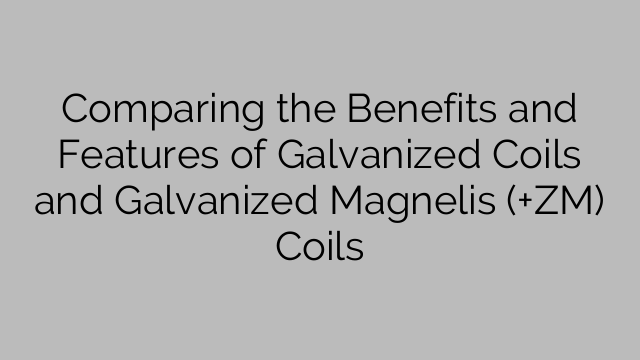Galvanized steel is a popular choice for many construction and manufacturing projects due to its corrosion-resistant properties. It is often used to make everything from industrial machinery to household appliances, and is also commonly used in the construction of buildings and infrastructure.
When it comes to galvanized steel, there are a few different options available, and two of the most popular choices are galvanized coils and galvanized Magnelis (+ZM) coils. Both options offer their own unique benefits and features, and it’s important to understand the differences between the two in order to make an informed decision for your specific project needs.
Galvanized coils are steel coils that have been coated with a layer of zinc in order to protect the underlying steel from corrosion. This process, known as galvanization, helps to extend the lifespan of the steel and makes it suitable for use in a wide range of applications.
On the other hand, galvanized Magnelis (+ZM) coils take the galvanization process a step further. In addition to the layer of zinc, these coils are also coated with a layer of magnesium. This extra step adds an additional layer of protection, making the steel even more resistant to corrosion and extending its lifespan even further.
One of the primary benefits of galvanized coils is their relatively low cost. They provide a good level of corrosion resistance at a price point that is competitive with other types of coated steel. This makes them a popular choice for many budget-conscious projects.
However, galvanized Magnelis (+ZM) coils offer a number of additional benefits that make them an attractive option for many applications. In addition to the extra layer of protection from magnesium, these coils also provide enhanced flexibility and impact resistance, making them suitable for use in more demanding environments.
Furthermore, galvanized Magnelis (+ZM) coils have been shown to provide superior corrosion protection in certain conditions, particularly in high-chloride environments. This makes them an excellent choice for applications that require a high level of corrosion resistance, such as coastal and marine environments, or areas where the steel will be exposed to harsh chemicals or industrial pollutants.
In terms of sustainability, both galvanized and galvanized Magnelis (+ZM) coils are environmentally friendly choices. The zinc and magnesium coatings used in these products are fully recyclable, making them a sustainable option for projects that aim to minimize their environmental impact.
Ultimately, the choice between galvanized coils and galvanized Magnelis (+ZM) coils will depend on the specific needs of your project. If cost is a primary concern and you require a basic level of corrosion protection, galvanized coils may be the best option for you. However, if you require a higher level of corrosion resistance, impact resistance, and flexibility, galvanized Magnelis (+ZM) coils may be the ideal choice.
In conclusion, both galvanized and galvanized Magnelis (+ZM) coils offer their own unique benefits and features. By understanding the differences between the two, you can make an informed decision that will best meet the needs of your project. Whether you’re working on a small-scale construction project or a large industrial application, choosing the right type of galvanized steel will help ensure the longevity and performance of your finished product.

